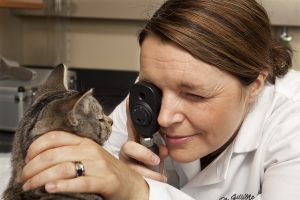
Meet Gillian McLellan, BVMS, PhD, a glaucoma specialist performing important research on glaucoma with the UW School of Veterinary Medicine and Department of Ophthalmology and Visual Sciences.
Dr. McLellan’s lab is focused on solving ocular problems that affect animals and humans, with a particular emphasis on glaucoma.
Dr. McLellan’s recent research stems from chance encounters with two different cats in Iowa. The cats had the same, rare form of glaucoma. As a researcher, her curiosity was piqued. If she could track down the cats’ parents it would provide an excellent opportunity to find out more about this strain of glaucoma. Luckily, McLellan was able to do so with the help of local veterinarians. Even more ideal was the fact that neither the mother nor the father had been spayed or neutered, as many people spay or neuter their pets before a health problem has a chance to manifest.
It turns out the two glaucomatous cats had over ten siblings, all with glaucoma. McLellan was able to take the cats to a medical facility in Iowa where she established a colony of offspring and began to study an animal model of this sight-stealing disease. The information she gains from this is helping provide key insights into understanding the causes of human congenital glaucoma, a disease that affects very young children.
Dr. McLellan brought her lab to the University of Wisconsin in 2006. The lab is uniquely positioned to apply the principles of “One Health” to vision research, by virtue of her joint faculty appointments as an Assistant Professor of Comparative Ophthalmology in both the School of Veterinary Medicine – where she sees clinical veterinary patients, teaches veterinary students and trains Residents in Comparative Ophthalmology- and Department of Ophthalmology and Visual Sciences, School of Medicine and Public Health, where her research laboratories are based.
“The One Health concept is a worldwide strategy for expanding interdisciplinary collaborations and communications in all aspects of health care for humans and animals. The synergy achieved will advance healthcare for the 21st century and beyond by accelerating biomedical research discoveries, enhancing public health efficacy, expeditiously expanding the scientific knowledge base and improving medical education and clinical care. When properly implemented, it will help protect and save untold millions of lives in our present and future generations.”
Source: www.onehealthinitiative.com
A vital component of her research is the strong collaborative relationships that exist between her laboratory, other members of the vision research community in the Glaucoma Research Group and the McPherson Eye Research Institute, as well as other clinicians and collaborators in the School of Veterinary Medicine, School of Medicine and Public Health and the College of Engineering.